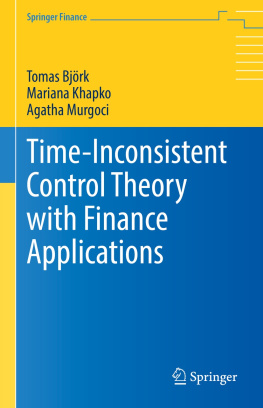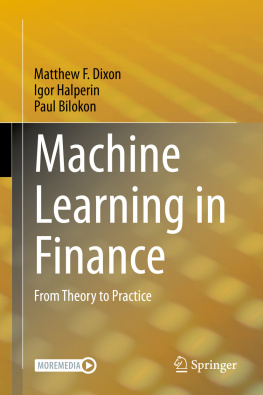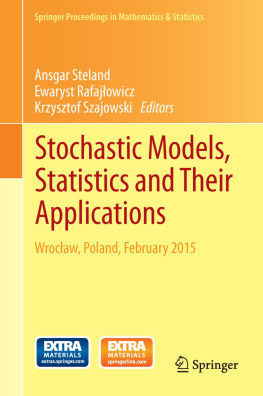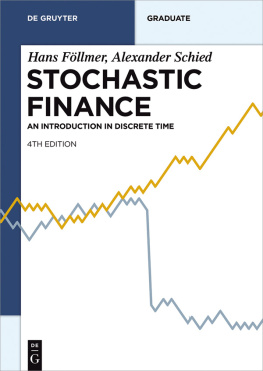Springer Finance
Series Editors
Marco Avellaneda
New York University, New York, NY, USA
Giovanni Barone-Adesi
Universita della Svizzera Italiana, Lugano, Switzerland
Francesca Biagini
Munich University of Applied Sciences, Munich, Germany
Bruno Bouchard
Paris Dauphine University, Paris, France
Mark Broadie
Columbia University, New York, NY, USA
Mark H. A. Davis
Imperial College London, London, UK
Emanuel Derman
Columbia University, New York, NY, USA
Paolo Guasoni
Dublin City University, Dublin, Ireland
Claudia Klppelberg
TUM, Zentrum f. Mathematik, Garching by Munich, Munich, Germany
Mathieu Rosenbaum
cole Polytechnique, Palaiseau, France
Walter Schachermayer
Universitt Wien, Wien, Austria
The Springer Finance series, launched in 1998, is addressed to students, academic researchers and practitioners working on increasingly technical approaches to the analysis of financial markets. It covers mathematical and computational finance broadly, reaching into foreign exchange, term structure, risk measure and management, portfolio theory, equity derivatives, energy finance and commodities, financial economics.
All titles in this series are peer-reviewed to the usual standards of mathematics and its applications.
More information about this series at http://www.springer.com/series/3674
Tomas Bjrk , Mariana Khapko and Agatha Murgoci
Time-Inconsistent Control Theory with Finance Applications
1st ed. 2021

Logo of the publisher
Tomas Bjrk
Stockholm School of Economics, Stockholm, Sweden
Mariana Khapko
University of Toronto, Toronto, ON, Canada
Agatha Murgoci
rsted, Hellerup, Denmark
ISSN 1616-0533 e-ISSN 2195-0687
Springer Finance
ISBN 978-3-030-81842-5 e-ISBN 978-3-030-81843-2
https://doi.org/10.1007/978-3-030-81843-2
Mathematics Subject Classication (2010): 49L20 49L99 49N10 49N90 60J05 60J20 60J70 91A10 91A80 91B02 91B50 91B70 91G10 91G80 91-02
The Editor(s) (if applicable) and The Author(s), under exclusive license to Springer Nature Switzerland AG 2021
This work is subject to copyright. All rights are solely and exclusively licensed by the Publisher, whether the whole or part of the material is concerned, specifically the rights of translation, reprinting, reuse of illustrations, recitation, broadcasting, reproduction on microfilms or in any other physical way, and transmission or information storage and retrieval, electronic adaptation, computer software, or by similar or dissimilar methodology now known or hereafter developed.
The use of general descriptive names, registered names, trademarks, service marks, etc. in this publication does not imply, even in the absence of a specific statement, that such names are exempt from the relevant protective laws and regulations and therefore free for general use.
The publisher, the authors and the editors are safe to assume that the advice and information in this book are believed to be true and accurate at the date of publication. Neither the publisher nor the authors or the editors give a warranty, expressed or implied, with respect to the material contained herein or for any errors or omissions that may have been made. The publisher remains neutral with regard to jurisdictional claims in published maps and institutional affiliations.
This Springer imprint is published by the registered company Springer Nature Switzerland AG
The registered company address is: Gewerbestrasse 11, 6330 Cham, Switzerland
Preface
The purpose of this book is to present an overview of, and introduction to, the time-inconsistent control theory developed by the authors during the last decade. The theory is developed for discrete as well as continuous time, and the kernel of the content is drawn mainly from our journal articles Bjrk and Murgoci (2014), Bjrk et al. (2017), and Bjrk et al. (2014). Starting from these articles, we have included more examples and substantially simplified the exposition of the discrete-time theory compared with that of Bjrk and Murgoci (2014). Moreover, we have extended our framework to study time-inconsistent stopping problems, including stopping problems with non-exponential discounting, mean-variance objective, and distorted probabilities. Alongside our own results we have included discussions of recent developments in the field. In order to make the text more self-contained we have also added a brief recapitulation of optimal control and stopping in discrete and continuous time.
It is important to recognize that the analysis of time inconsistency has a long history in economics and finance literature. The idea of time consistency was alluded to by Samuelson (1937) when introducing the most commonly used time-discounting method in economics, exponential discounting. Strotz (1955) in his seminal paper pointed out that any other choice of discounting function, apart from the exponential case, will lead to a dynamically inconsistent problem. More generally, in order to achieve dynamic consistency and analyze the agents problem with a standard toolkit, one needs to make specific and often restrictive assumptions about the objective functional the agent is maximizing (or minimizing). If the agents objective does not conform to these assumptions (see Remark ), time consistency fails to hold and the usual concept of optimality does not apply. Loosely speaking, this means that the agents tastes change over time, so that a plan for some future period deemed optimal today is not necessarily optimal when that future period actually arrives.
How can one handle time-inconsistent problems? One approach is to look for a solution that is optimal today, ignoring the time inconsistency. Strotz (1955) refers to an agent who fails to recognize the time inconsistency issue and adopts such an approach as spendthrift. The term later coined in the literature is nave. The nave agents strategies are myopic and constantly changing. Strotz (1955) also outlines two approaches for modeling a sophisticated agent who is aware of the time inconsistency of their tastes: the strategy of pre-commitment and that of consistent planning. In the former case, the agent decides on a plan of action that is optimal today and commits to it, ignoring the incentives to revise it in the future. In the latter case, the agent internalizes the incentives to deviate and treats them as a constraint, thus aiming to arrive at a deviation-proof solution. Importantly, in both cases the agent recognizes that their today self and their future selves may have conflicting tastes.
In our work we choose to follow the consistent planning approach of Strotz (1955) in that an agents strategies are taken to be the outcome of an intrapersonal game whose players are successive incarnations of the same agent. Essentially, we replace the usual concept of optimality with a more general concept of intrapersonal equilibrium and look for Nash subgame-perfect equilibrium points (Selten, 1965). Using this game-theoretic approach, we present an extension of the standard dynamic programming equation, in the form of a system of nonlinear equations, for determining the intrapersonal equilibrium strategy. This extended system, loosely speaking, accounts for the incentives to deviate as time evolves and an agents tastes change. This means that, for a general Markov process and a fairly general objective functional, we obtain a plan that the agent will actually follow. We fully acknowledge that, while our focus here is on the game-theoretic approach, the other approaches that have been studied in the literaturethe problem of a nave agent who reoptimizes as time goes by or that of a sophisticated agent who is able to pre-commitare both interesting and relevant.















